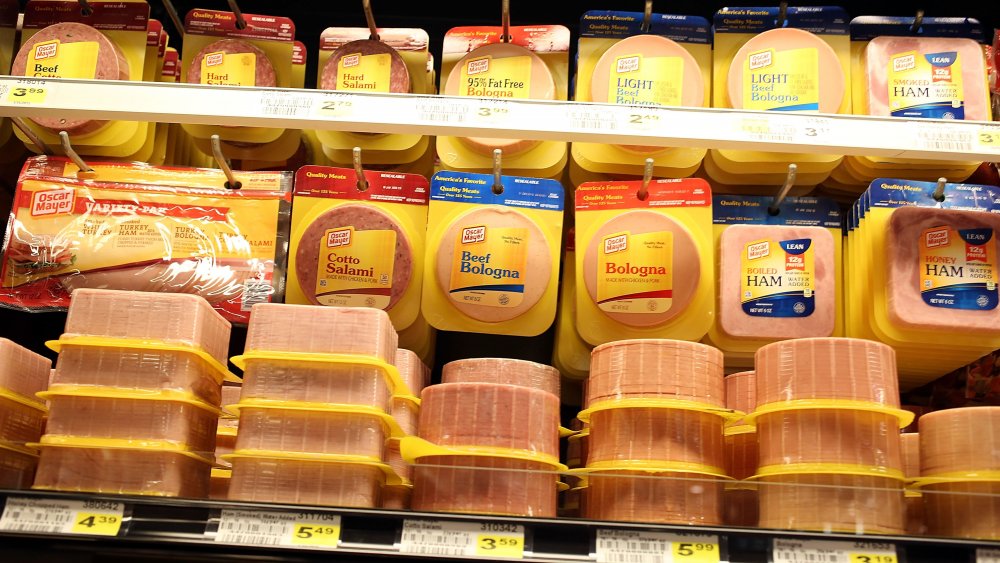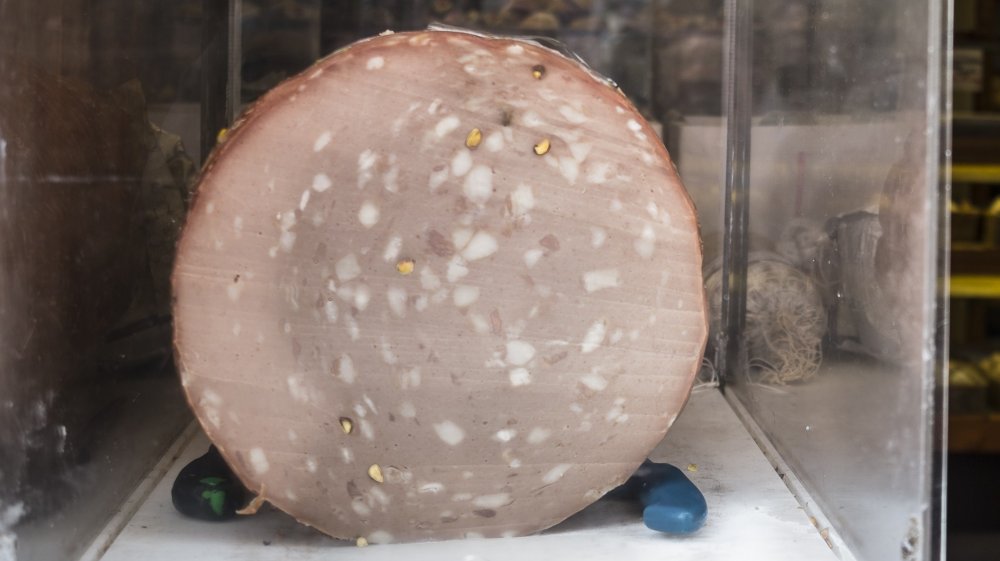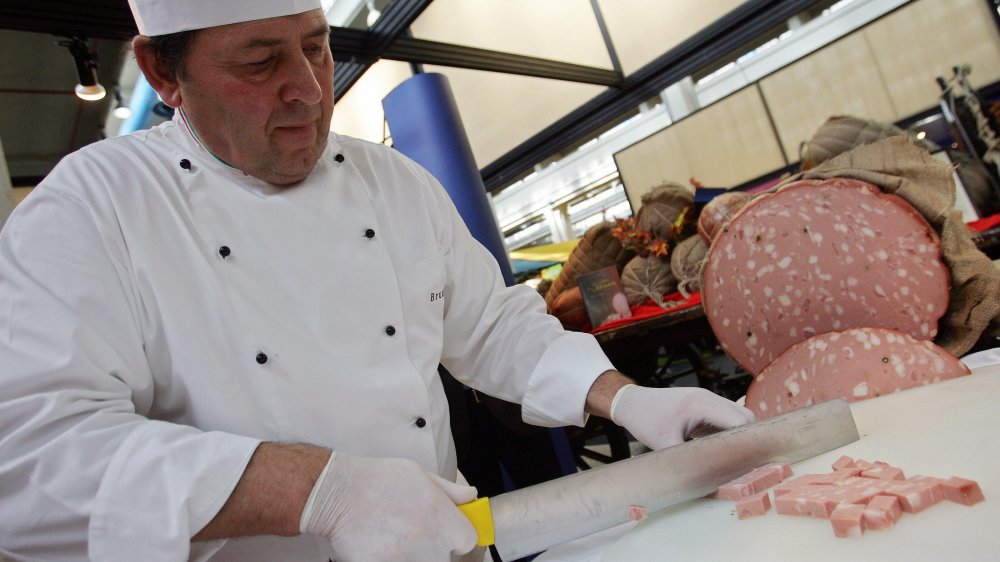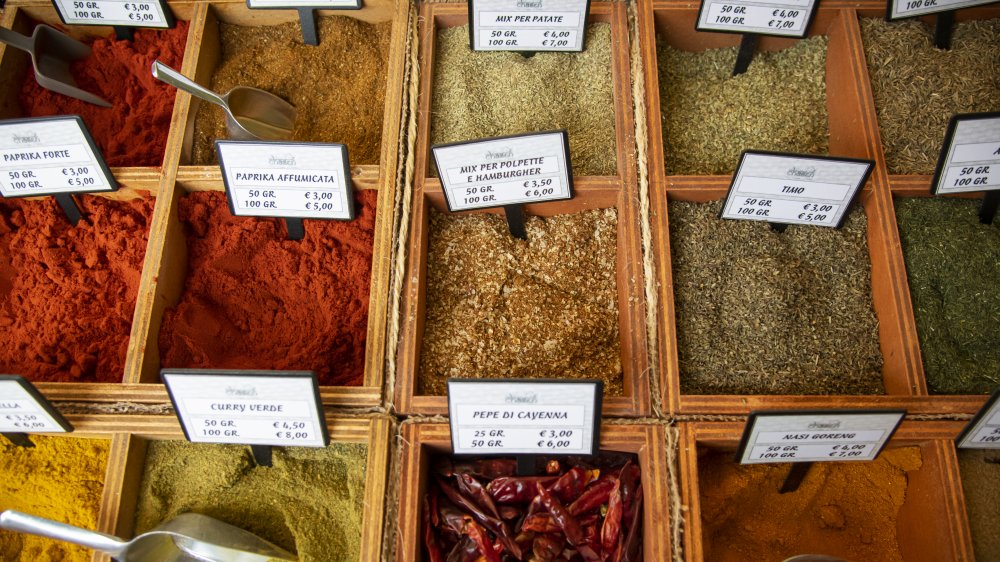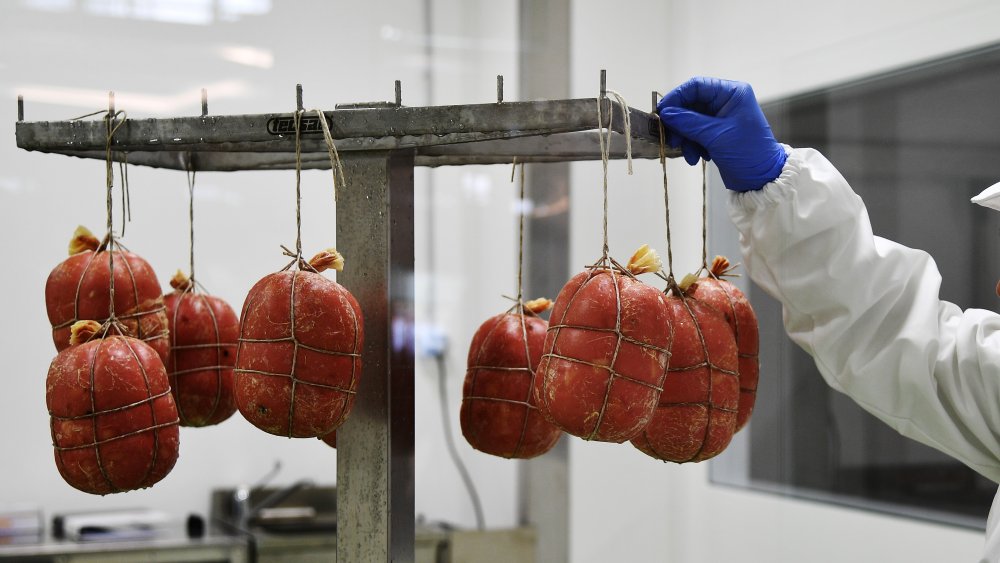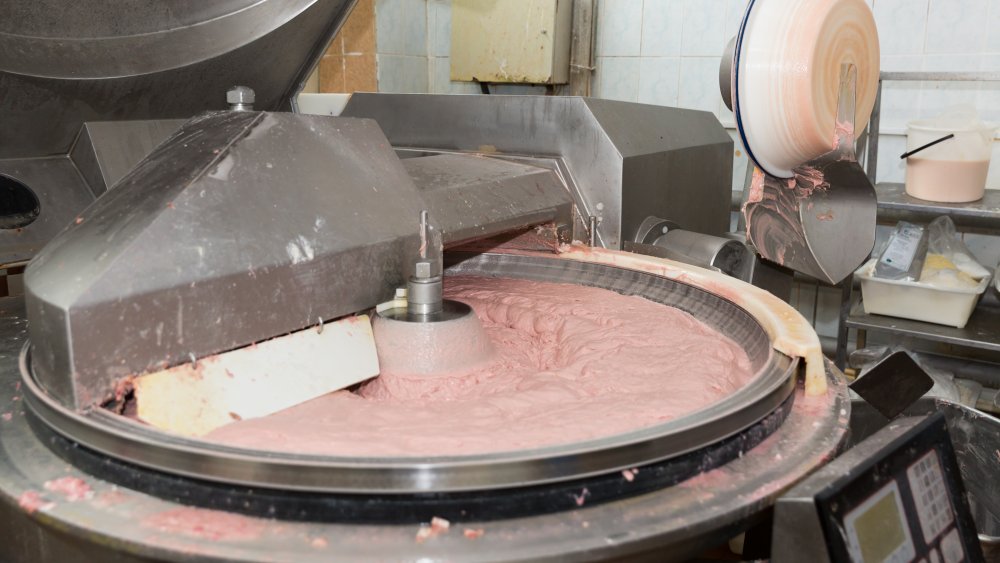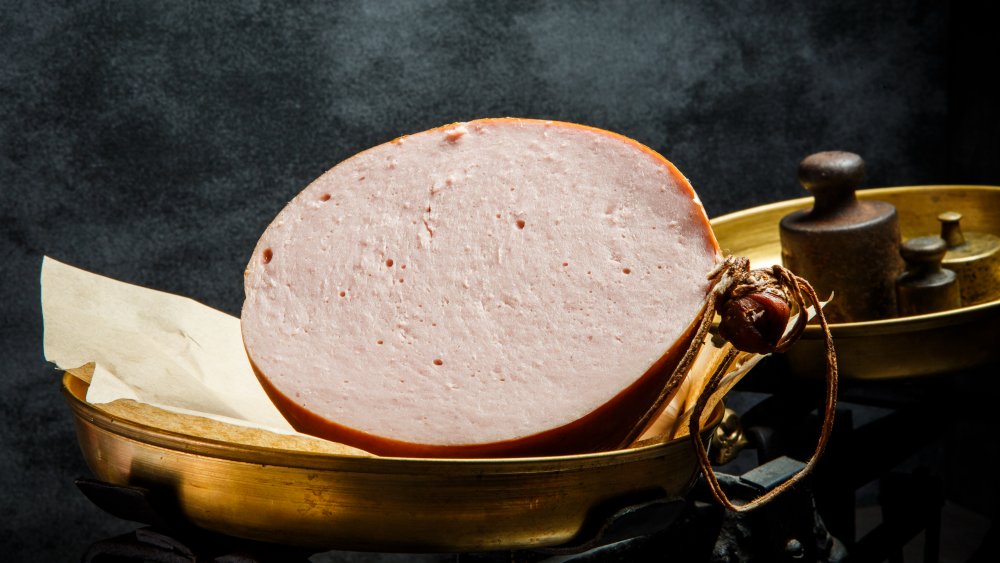This Is How Bologna Is Really Made
Ah, bologna.
Hate it or love it, bologna is an American lunchroom staple, and there's no other meat quite like it. It draws on a little bit of everything: the classic, thin and floppy slices of meat are reminiscent of other deli meats like salami or prosciutto, but it's got a flavor profile and texture more similar to heavily processed "mystery meats" like hot dogs and Spam.
Bologna holds a special place in the American culinary ethos. As professor of food studies at New York University, Amy Bentley, told Eater, "It's been inserted into the national psyche of despicable foods, laughable foods. 'That's baloney, that's crazy.' That's how we think of it. It's been embedded in our brains that way."
There's no question about it — bologna is indeed embedded in the American mind as one of those foods that you eat, but don't really question what it's actually made out of and how it's actually made (and maybe you don't even really want to know). But one can't help but wonder, as we eat our stacked up slices of mystery meat tucked in between two slices of white bread (and maybe a healthy slathering of mayonnaise if we're lucky), what exactly is this stuff?
This is how bologna is actually made.
Bologna is derived from an Italian cold cut called mortadella
The name "bologna" actually comes from the name of a large city in northern Italy (in the native Italian, the word's pronounced "bo-LON-ya"), where butchers produce a related meat, called mortadella — an ancient ancestor of the sandwich filling we know and love today. According to Italy Magazine, the city of Bologna evokes images of the pink, fatty lunch meat in the minds of Italians all over the country.
Mortadella has roots that go all the way back to the Roman Empire — as Italy Magazine reported in 2013, pieces of Classical Roman art and literature, such as an old stone carving depicting a butcher grinding meat and spices for mortadella with a mortar and pestle, highlight the fact that the citizens of the Roman Empire were indeed munching on mortadella.
The meat's main wow-factor for Ancient Romans? The salt. By the Middle Ages, the people who cured the meat using a salt-cure process like the one for mortadella, had formed a powerful guild that had a large financial backing in the Italian states. The guild drove mortadella costs up to nine times as much as a loaf of bread, according to Italy Magazine.
But the meat has come a long way since those days — although American producers of our version of mortadella might also have big bucks in the bank account (think Oscar Mayer), bologna is certainly not the bourgeois meat it once was in Italy.
If you're really interested in the history of America's favorite mystery meat, you can visit the Museum of the History of Bologna in the Palazzo Pepoli. Though the museum as a whole is dedicated to the history of the city, there is an entire section dedicated to the meat of the same name, telling you just how proud they are of their namesake.
The European Union strictly mandates that mortadella be made from pork
The European Union is notorious for regulating the authenticity of various food products, from cheese to champagne, and mortadella is no exception. In order for a meat product to be legally considered mortadella back in Italy, it has to meet a number of strict certifications. Namely, authentic, traditional mortadella must be made using a pork sausage — no other meats can legally be used in traditional Italian mortadella.
Additionally, authentic mortadella (known as "Mortadella Bologna IGP") has bits of fat incorporated in the sausage, giving slices of the deli meat a characteristically mottled appearance, with translucent white bits of fat poking out from the pink pork. The ground meat and fat cubes are then combined with spices like salt and pepper, and placed in a sausage casing. Unlike other cured meats, like salami and prosciutto, mortadella is not dry cured — rather, after it's finished cooking (sometimes for a long time), mortadella is sprayed with cool water, so it doesn't have the same, bone dry texture of more well-known cured meats.
American versions of bologna have somewhat looser standards when it comes to ingredients
American bologna is not mortadella — rather, it's a cousin of mortadella. A distantly related one at that. As American laws don't strictly regulate what recipes can and can't be called bologna, our take on the traditional Italian deli meat has taken on a much more dynamic evolution process, whereby different brands use a variety of different meats and spice blends to produce their bologna.
However, USDA regulations do actually have a strict clause that differentiates our take on bologna from traditional mortadella: like hot dogs, American bologna does not have small flecks of fat or spices in it, as the USDA dictates that all of the meat and additives must be pulverized into tiny little unrecognizable particles, according to the Huffington Post. That's why our bologna looks so very different from it's speckled cousin.
But beyond that one detail, it's pretty much fair game as to what can go into your bologna: different brands and versions utilize different meats, from the traditional pork, to beef (or blends of both) to more off-the-wall renditions like chicken bologna (in fact, Oscar Mayer uses all three of those meats in their bologna). The USDA does say, however, that label on American bologna must tell you what kind of meat you're getting.
Bologna uses some of the least desirable scraps of meat
In typical American fashion, the cut of meat from which bologna is derived has changed considerably from that of its Italian ancestor. While mortadella typically uses meat from the back and cheek of the pig, bologna's makeup consists of what's known as "raw skeletal muscle" — and other raw meat byproducts, such as the heart, kidney, or liver of the pig.
Raw skeletal muscle is pretty much exactly what it sounds like: the muscular tissue that attaches directly to the skeleton of the pig (or other livestock). This cut of meat is composed mainly of muscle fibers and connective tissues, and is a major component for many other highly processed meats, like hot dogs and other pre-cooked sausages.
The addition of meat byproducts like the internal organs is a way for manufacturers to ensure they get the biggest bang for their buck — adding in parts of the animal that are more difficult to sell like the heart and liver ensures that the whole animal can be marketed, rather than simply disposing of the undesirables. Of course, if you're getting these byproducts in your bologna, it is possible to find out. The USDA says the byproducts must be individually named, as well as what species they come from, in the ingredients list.
Ground meat is flavored with spices like coriander and black pepper to make bologna
According to the Huffington Post, both bologna and mortadella draw on a similar flavor profile, which comes from the unique blend of spices used to flavor the two meats: coriander, celery seeds, nutmeg, black pepper, and myrtle berries.
Essentially, this is the same blend of spices used in traditional blends of pickling spices — except, of course, for the myrtle berries. Small amounts of nutmeg and black pepper work to give bologna and mortadella that somewhat warm, comforting flavor, while coriander and celery seeds add just the right touch of bitterness to take the edge off of the potentially overpowering saltiness from all that sodium that's blended into the sausage. In addition to this spice blend, the popular bologna manufacturer Oscar Mayer includes ground mustard powder, beef stock, and paprika, which all work to further develop the savory flavors of the cold cut and make it stand out from all the other bologna products on the block.
What really differentiates mortadella and bologna from their other lunchtime competition is the addition of myrtle berries, which, according to the Huffington Post, are the most distinctive flavoring added to the lunch meats, giving it a more unique flavor profile that's not found in other deli meats.
Myrtle berries give bologna its oomph factor
If you're reading this wondering what the heck a myrtle berry is, fear not — while bologna surely has a lot of peculiar chemical additives that we'll get to in a bit, myrtle berry is one of the few things that's actually an all-natural and relatively unprocessed component of the popular sandwich filling.
The myrtle berry is indigenous to the Mediterranean (though it's especially prominent on the islands of Sardinia and Corsica), and has found its way into a number of different Italian dishes beyond mortadella. Myrtle leaves are an especially popular flavoring for roast pork dishes, so it should come as no surprise that its berries are the primary flavoring agent in mortadella, and by extension, its American cousin, bologna. In fact, the name "mortadella" might even be related to the Italian word for myrtle, "mirto," since the spice gives the cold cut such a characteristic, semi-spicy flavor profile. Myrtle berries have a slightly astringent, citrus-like flavor, comparable to juniper berries and rosemary, according to The Epicentre.
Myrtle berries are also the main flavor component in a popular Italian liqueur known simply as mirto, as Liquor.com reported back in 2017. The digestif has a flavor that pairs well with gin (which is derived from juniper berries, by the way), and the Huffington Post says it "kind of tastes like bologna." Um, bottoms up?
American bologna producers add a number of chemical additives to their bologna meat
As Mel Magazine's Ian Lecklitner noted in a 2019 analysis of Oscar Mayer's bologna ingredients, there are 18 ingredients in a slice of the company's beef bologna. That's a whole lot of ingredients in a lunch meat that started out as something relatively simple — and those ingredients aren't all meat and spices either. While things aren't all bad, there are a number of questionable additives, from corn syrup to a number of strange chemical compounds, in the country's most notorious bologna brand's cold cuts.
Processed meats like bologna tend to get a lot of flack for potentially having carcinogenic properties — Oscar Mayer's bologna is no exception. In fact, one of the ingredients in the company's bologna, sodium nitrite, is a common additive in processed meats that may contribute to their cancer-causing properties. While sodium nitrite is an effective preservative in bologna, hot dogs, and many other meat-based products (and it can improve the flavor and color of the foods it's added to), the International Agency for the Research of Cancer (via Medical News Today) has says that ingesting nitrites is likely linked to higher rates of bowel cancer.
One other risky additive in Oscar Mayer's bologna is sodium phosphate, which is generally used to cure meat products and help keep them moist. And while the FDA does consider sodium phosphate to be generally safe to eat in small quantities, it has been linked to elevated rates of mortality for those with kidney disease and cardiovascular disease.
The minced meat and herbs are blended into a sausage formation to make bologna
After all the meat and fats and spices in the bologna are ground up into a fine mince, the mixture is funneled into a sausage casing. Traditionally, sausage casings are made from animal intestines — oftentimes, the same kind of animal as the meat from which the sausage is derived (so in the case of a traditional mortadella, this would be pig intestine).
Animal intestines can be hard to come by, nowadays — according to research published in Bioactive Seaweeds for Food Applications, many sausage producers have turned to using a chemically derived sausage casing, often using compounds such as cellulose, collagen, or plastics. Even traditional Italian mortadella is allowed to contain an artificial sausage casing like these, since it can be inconvenient and expensive to obtain the intestines necessary to create a 100 percent natural casing.
You may find that some of the bologna you purchase in stores has what resembles a red seal around it — this is most likely an artificial casing. Most popular brands (Oscar Mayer included) remove the casing before packaging their bologna according to the USDA, but if you're unsettled at the thought of accidentally eating a little plastic in your next bologna sandwich be sure to check for the red casing and peel it off. Oscar Mayer says all of their casing are plant-derived, so if you do happen to digest any, there's no need to panic.
Once the meat has been funneled into its proper casing, it's on to the next step: smoking.
In America, that minced meat that makes up bologna is really a meat batter
As we've mentioned, the USDA doesn't have the same strict regulations on defining bologna that the European Union has for mortadella — but there is one particularly interesting regulation that really separates American bologna from the more traditional and highbrow Italian mortadella: it's essentially mandated by law that bologna be made using a meat batter, rather than finely ground up or minced meat.
This is why bologna and mortadella look so different, despite having similar flavor profiles: while the base of mortadella is a rather heterogeneous blend of meat, fat and spices, all those components must be comminuted (meaning that they have to be "reduced to minute particles," as the USDA writes) when making bologna in America.
Meat batters have a fluid, homogeneous consistency that's created by the emulsion of animal fats and a liquid (in the case of a meat batte, this liquid is water) — the protein in the meat serves to combine the two liquids into a stable mixture. In order to do this effectively, the proteins in the meat must be ground down to very fine particles (i.e., comminuted), and manufacturers must be very careful about the amount of salt and acidic ingredients they add to the mixture, lest they inadvertently destabilize the batter. Once the bologna batter's been produced, it's funneled into a casing.
Lastly, the sausage is cooked and cooled to make bologna
This final step is probably the least surprising part about the whole bologna-making process, but it's still a pretty important one. After the meat and spice emulsion has been transferred to a sausage casing (or casing of some sort), it's then cooked. Depending on the brand and variant of bologna, this cooking process can differ greatly in the United States.
According to the European Union's regulations on producing mortadella, the Italian version is slow-cooked in a warm room for a few hours to a full day, depending on the size of the sausages being cooked. The Italian mortadella making process features dry-air heaters that get the internal temperature of the sausage up to around 158 degrees Fahrenheit. Once the cooking process is complete, it's sprayed with cool water and cooled down to stabilize the product before packaging. This misting, followed by the final cooling process, is what gives bologna and mortadella both their distinctly flabby textures, ensuring that the meat doesn't dry up too much like other popular cold cuts, such as ham or pepperoni.
In the United States, bologna manufacturers have two options for finishing of their bologna products. According to USDA regulations, bologna is a member of a family of processed meats called "frankfurters," which must be smoked or cooked. Unlike its Italian cousin, mortadella, bologna features a smoky flavor, comparable to bacon or hot dogs — this is just another factor that differentiates the flavor profile of Oscar Mayer's bologna (and other American favorites) from a highbrow IGP certified mortadella product.
